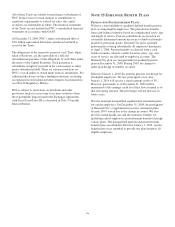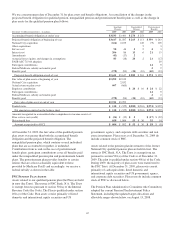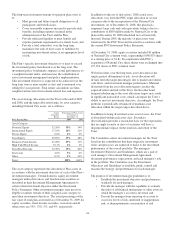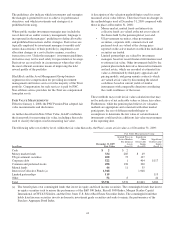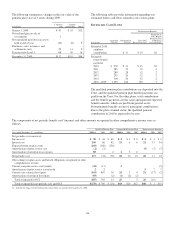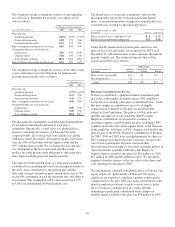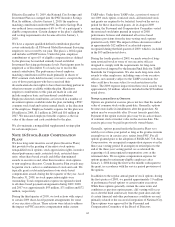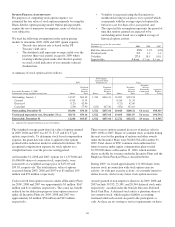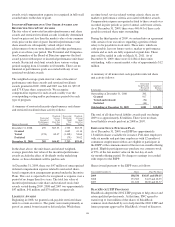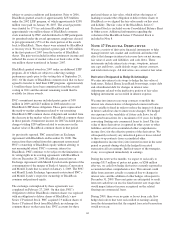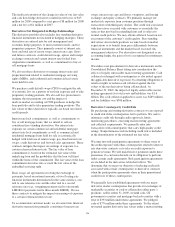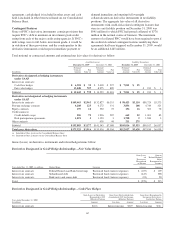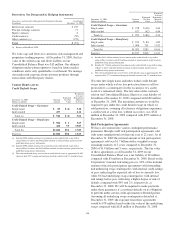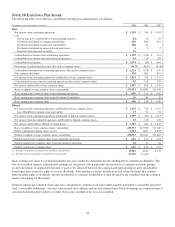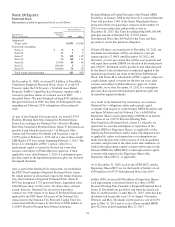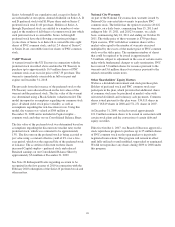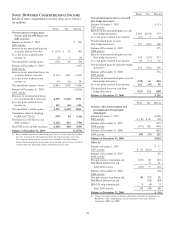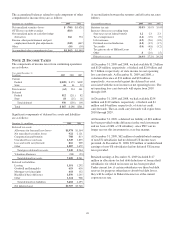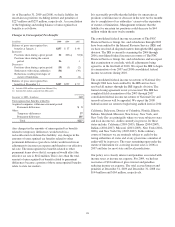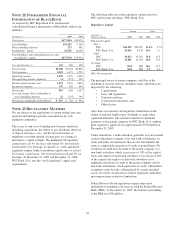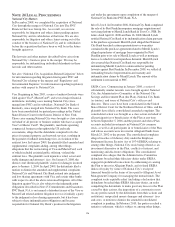PNC Bank 2009 Annual Report Download - page 150
Download and view the complete annual report
Please find page 150 of the 2009 PNC Bank annual report below. You can navigate through the pages in the report by either clicking on the pages listed below, or by using the keyword search tool below to find specific information within the annual report.The ineffective portion of the change in value of our fair value
and cash flow hedge derivatives resulted in net losses of $45
million for 2009 compared to a net gain of $8 million for 2008
and a net loss of $1 million in 2007.
Derivatives Not Designated in Hedge Relationships
The derivative portfolio also includes free standing derivative
financial instruments not included in hedging strategies. These
derivatives are entered into for risk management and
economic hedge purposes, to meet customer needs, and for
proprietary purposes. They primarily consist of interest rate,
basis and total rate of return swaps, interest rate caps, floors
and futures contracts, credit default swaps, option and foreign
exchange contracts and certain interest rate-locked loan
origination commitments, as well as commitments to buy or
sell mortgage loans.
We also use these derivatives to manage interest rate and
prepayment risk related to residential mortgage servicing
rights (MSRs), and residential and commercial real estate
loans held for sale.
We purchase credit default swaps (CDS) to mitigate the risk
of economic loss on a portion of our loan exposure and to take
proprietary trading positions. We also sell loss protection to
mitigate the net premium cost and the impact of
mark-to-market accounting on CDS purchases to hedge the
loan portfolio and to take proprietary trading positions. The
fair values of these derivatives typically are based on related
credit spreads.
Interest rate lock commitments, as well as commitments to
buy or sell mortgage loans, that we intend to sell are
considered free-standing derivatives. Our interest rate
exposure on certain commercial and residential mortgage
interest rate lock commitments as well as commercial and
residential mortgage loans held for sale is economically
hedged with total rate of return swaps, pay-fixed interest rate
swaps, credit derivatives and forward sales agreements. These
contracts mitigate the impact on earnings of exposure to a
certain referenced interest rate. The fair value of loan
commitments is based on the estimated fair value of the
underlying loan and the probability that the loan will fund
within the terms of the commitment. The fair value of the loan
commitment also takes into account the fair value of the
embedded servicing right.
Basis swaps are agreements involving the exchange of
payments, based on notional amounts, of two floating rate
financial instruments denominated in the same currency, one
tied to one reference rate and the other tied to a second
reference rate (e.g., swapping payments tied to one-month
LIBOR for payments tied to three-month LIBOR). We use
these contracts to mitigate the impact on earnings of exposure
to a certain referenced interest rate.
To accommodate customer needs, we also enter into financial
derivative transactions primarily consisting of interest rate
swaps, interest rate caps and floors, swaptions, and foreign
exchange and equity contracts. We primarily manage our
market risk exposure from customer positions through
transactions with third-party dealers. The credit risk associated
with derivatives executed with customers is essentially the
same as that involved in extending loans and is subject to
normal credit policies. We may obtain collateral based on our
assessment of the customer’s credit quality. Free-standing
derivatives also include positions we take based on market
expectations or to benefit from price differentials between
financial instruments and the market based on stated risk
management objectives. For derivatives not designated as an
accounting hedge, the gain or loss is recognized in noninterest
income.
We utilize a net presentation for derivative instruments on the
Consolidated Balance Sheet taking into consideration the
effects of legally enforceable master netting agreements. Cash
collateral exchanged with counterparties is also netted against
the applicable derivative exposures by offsetting obligations to
return or rights to reclaim cash collateral against the fair
values of the net derivatives being collateralized. At
December 31, 2009, the impact of legally enforceable master
netting agreements for total assets and liabilities was $1.6
billion. The cash collateral applied for assets was $269 million
and for liabilities was $506 million.
Derivative Counterparty Credit Risk
By purchasing and writing derivative contracts we are exposed
to credit risk if the counterparties fail to perform. We seek to
minimize credit risk through credit approvals, limits,
monitoring procedures, executing master netting agreements
and collateral requirements. We generally enter into
transactions with counterparties that carry high quality credit
ratings. Nonperformance risk including credit risk is included
in the determination of the estimated net fair value.
We enter into risk participation agreements to share some of
the credit exposure with other counterparties related to interest
rate derivative contracts or to take on credit exposure to
generate revenue. We will make/receive payments under these
guarantees if a customer defaults on its obligation to perform
under certain credit agreements. Risk participation agreements
are included in the derivatives table that follows. We
determine that we meet our objective of reducing credit risk
associated with certain counterparties to derivative contracts
when the participation agreements share in their proportional
credit losses of those counterparties.
We generally have established agreements with our major
derivative dealer counterparties that provide for exchanges of
marketable securities or cash to collateralize either party’s
positions. At December 31, 2009, we held cash, US
government securities and mortgage-backed securities with a
total of $393 million under these agreements. We pledged
cash of $776 million under these agreements. To the extent
not netted against derivative fair values under a master netting
146


